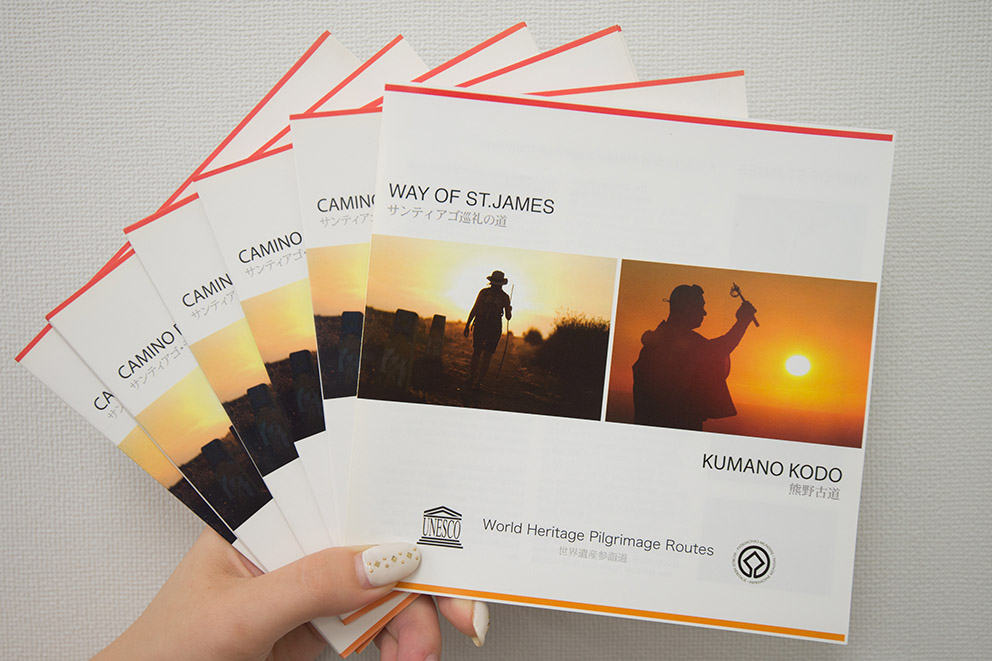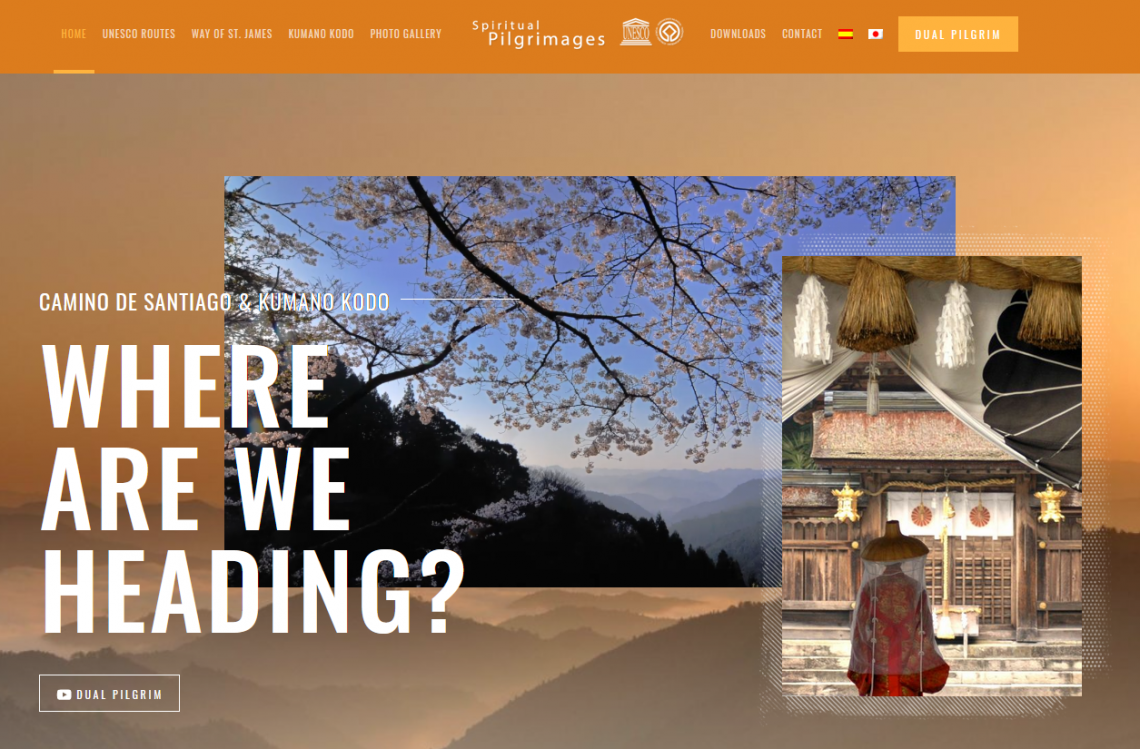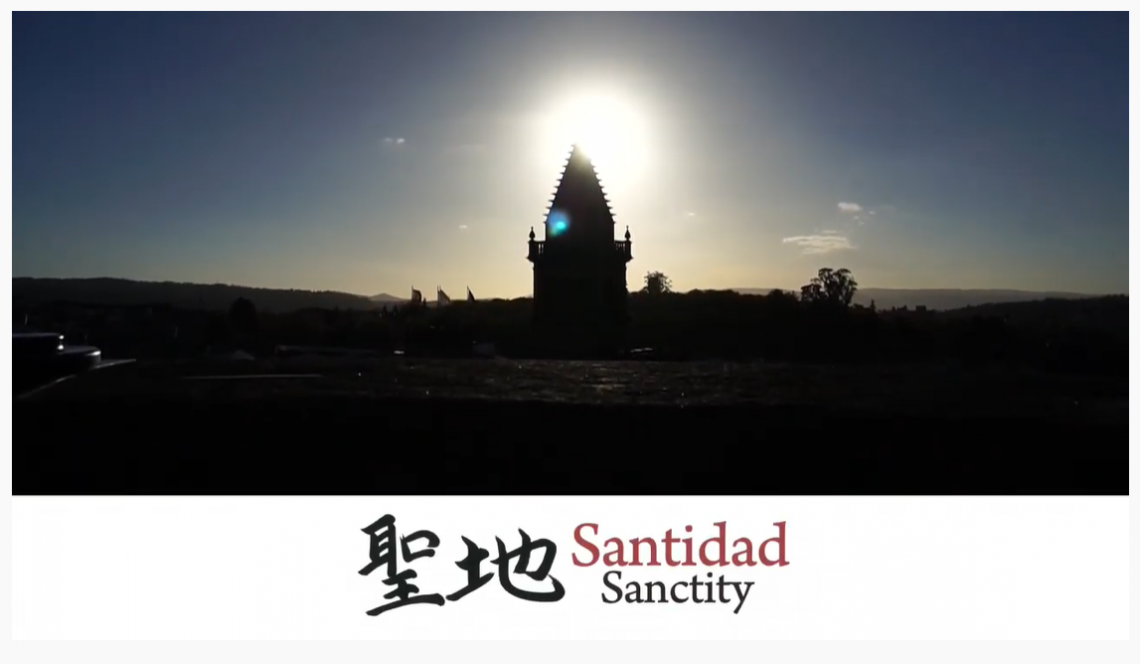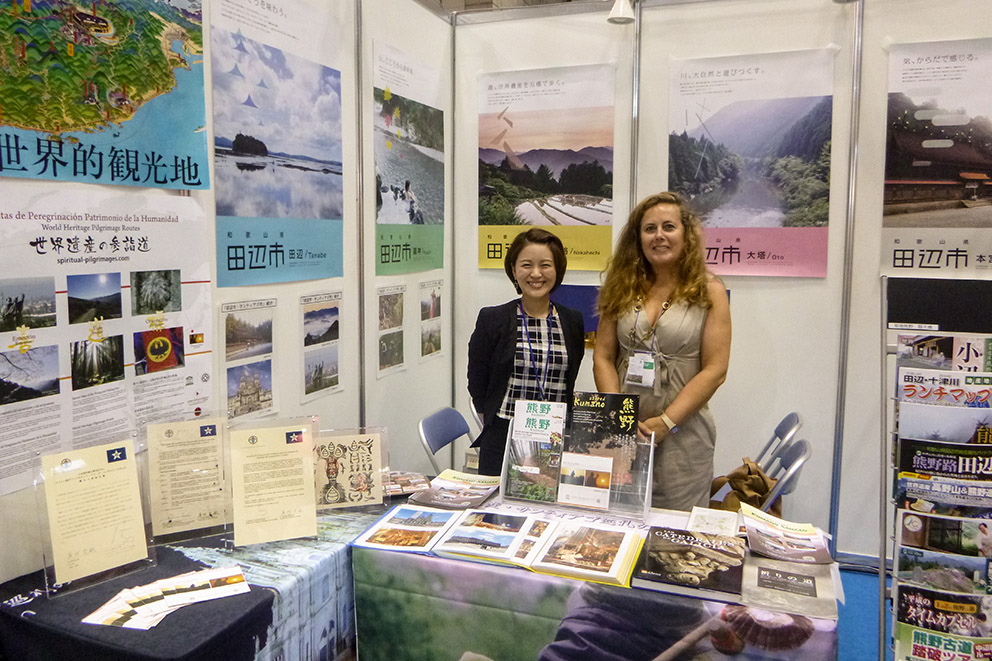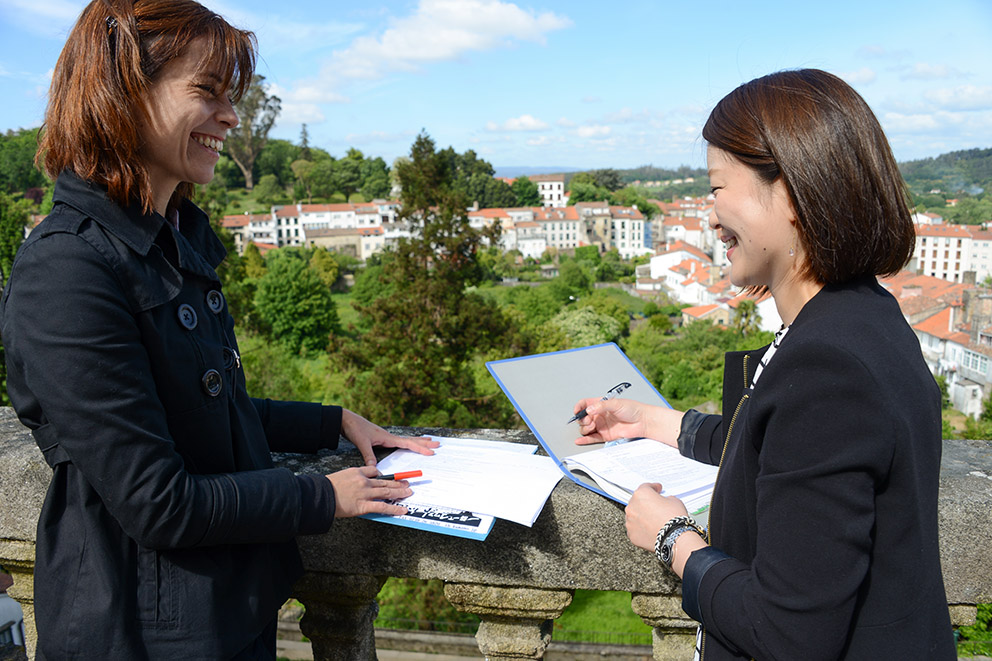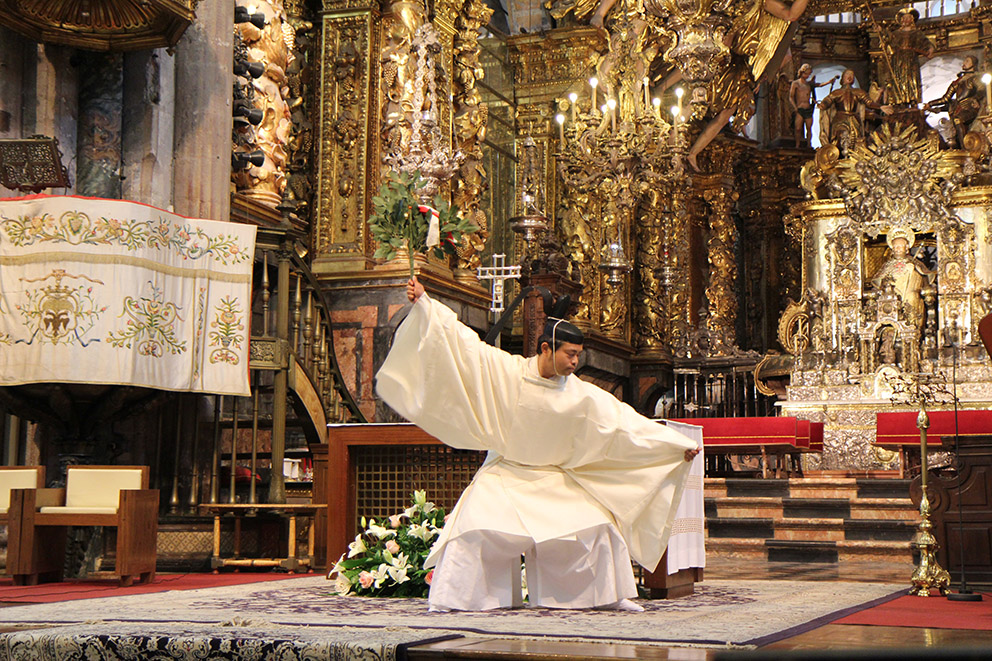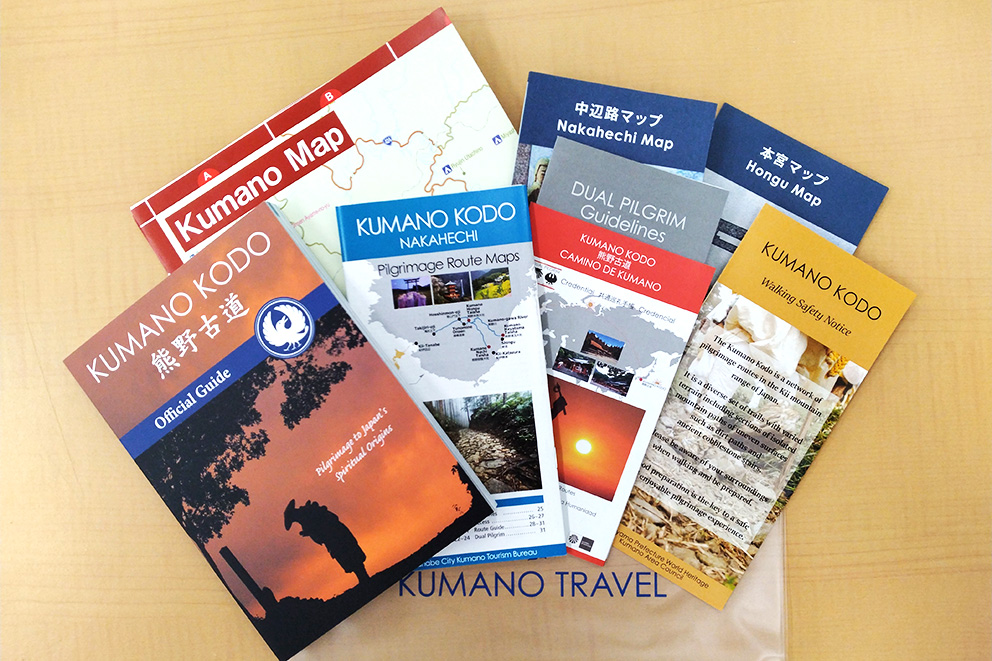Overview
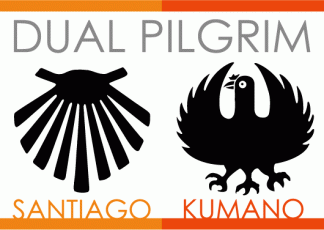
A “Dual Pilgrim” is someone who has walked both the Kumano Kodo and the Way of St.James (Camino de Santiago).
This program was developed to celebrate, honor, and share the stories of those who have completed both of these UNESCO World Heritage pilgrimage routes and began on Feb 1st, 2015.
Dual Pilgrims receive a limited edition “DUAL PILGRIM” pin badge and are featured on the Dual Pilgrim page of spiritual-pilgrimages.com. (Inclusion on the website is optional).
The Dual Pilgrim logo is a combination of a shell and a three-legged crow. The colors are shades of orange, often seen in beautiful sunrises and sunsets.
To receive the Dual Pilgrim status, pilgrims must complete one of the options for the Way of St. James, and one of the options for the Kumano Kodo, then register at a designated site.
Way of St. James Options
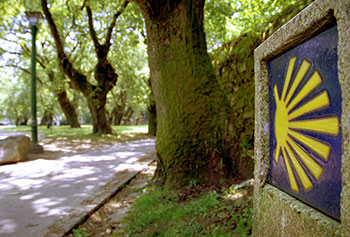
- at least the last 100 km on foot or by horse, or
- at least the last 200 km by bicycle
Kumano Kodo Options

There are five ways to qualify for the Kumano Kodo section of the Dual Pilgrimage.
① Takijiri-oji to Kumano Hongu Taisha on foot (~38 km) or
② Kumano Nachi Taisha to/from Kumano Hongu Taisha on foot (~30 km) or
③ Hosshinmon-oji to Kumano Hongu Taisha on foot (~7 km) plus a visit to Kumano Hayatama Taisha and Kumano Nachi Taisha or
④ Koyasan to Kumano Hongu Taisha on foot (~65 km) or
⑤ Ogigahama Mizugori Site, Tokei-jinja, two sites or more on Ohechi route, plus a visit to Kumano Hayatama Taisha, Kumano Nachi Taisha, and Kumano Hongu Taisha
※ Only walking is allowed on the Kumano Kodo. No bicycles or horses.
※ Please refer to the Stamp Lists below for locations of required stamps to complete the Kumano Kodo pilgrimage.
Dual Pilgrim Credential

The Dual Pilgrim Credential is a type of passport for pilgrims. It is used to collect stamps along the trail as a record of the walk. There are two sides, one for the Kumano Kodo and one for the Way of St. James.
To complete the walk in Santiago you need to go to the pilgrim’s office to receive the stamp from the cathedral. The completion stamp for the Kumano Kodo is located at the Kumano Hongu Taisha.
The Dual Pilgrim Credential is free of charge.
JAPAN
In Japan the credential is available at:
- TANABE Tourist Information Center (next to the JR Kii-Tanabe station)
- Kumano Hongu Heritage Center (near the Kumano Hongu Taisha, Hongu Town, Tanabe City)
- Kumano Kodo Kan Pilgrimage Center (next to Takijiri-oji, Nakahechi, Tanabe City)
- Shingu City Tourist Information Center
- Nachi-Katsuura Tourism Association tourist information center (next to JR Kii-Katsuura station)
- Central Information Center, Koyasan Shukubo Temple Lodging Association(near Senjuin-bashi bus stop)
- Koyasan Tourist Information Center
※ The Credential can also be picked-up at accommodations in Tanabe City, etc. depending on availability.
SPAIN
In Spain the credential is available at:
- Turismo de Santiago Information Center (near the Santiago Cathedral)
ONLINE
Order Kumano Kodo Pilgrim Pack (which includes credential) Online from the KUMANO TRAVEL Community Reservation System.
Stamps
Kumano Kodo Stamps
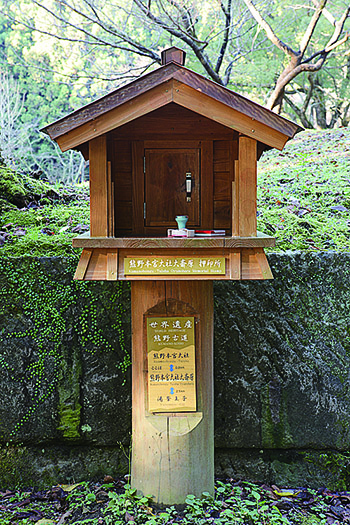
Stamps are located in wooden stands at most sites.
After use please close the ink pad so that it does not dry out for the next pilgrims.
The Kumano Kodo completion stamp is the Kumano Hongu Taisha one, so please remember to stamp this on the first page of the Kumano Kodo side of the credential under the heading “COMPLETION OF PILGRIMAGE”.
NOTE: Stamps at sacred sites sometimes change locations. Please ask at each shrine or temple if you are not able to locate the stamps.
Stamp List
NAKAHECHI
① Takijiri-oji to Kumano Hongu Taisha on foot (~38 km)
| Stamp Location | スタンプの場所 |
|---|---|
| Takijri-oji | 滝尻王子 |
| Nezu-oji | 不寝王子 |
| Takahara Kumano-jinja | 高原熊野神社 |
| Daimon-oji | 大門王子 |
| Jujo-oji | 十丈王子 |
| Osakamoto-oji | 大坂本王子 |
| Gyuba-doji Statue | 牛馬童子 |
| Chikatsuyu-oji | 近露王子 |
| Tsugizakura-oji | 継桜王子 |
| Hidehira-zakura Cherry Tree | 秀衡桜 |
| Jagata Jizo | 蛇形地蔵 |
| Yukawa-oji | 湯川王子 |
| Inohana-oji | 猪鼻王子 |
| Hosshinmon-oji | 発心門王子 |
| Mizunomi-oji | 水吞王子 |
| Fushiogami-oji | 伏拝王子 |
| Haraido-oji | 祓殿王子 |
| Kumano Hongu Taisha | 熊野本宮大社 |
② Kumano Nachi Taisha to/from Kumano Hongu Taisha on foot (~30 km)
| Stamp Location | スタンプの場所 |
|---|---|
| Kumano Hongu Taisha | 熊野本宮大社 |
| Oyunohara | 旧社地大斎原 |
| Ukegawa | 請川 |
| Ishido-jaya Teahouse remains | 石堂茶屋跡 |
| Kowaze Ferry remains | 小和瀬渡し場跡 |
| Koguchi | 小口 |
| Jizo-jaya Teahouse remains | 地蔵茶屋跡 |
| Kumano Nachi Taisha | 熊野那智大社 |
| Seiganto-ji | 青岸渡寺 |
| Hirou-jinja (Nachi Falls) | 飛瀧神社 |
③ Hosshinmon-oji to Kumano Hongu Taisha on foot (~7 km) plus a visit to Kumano Hayatama Taisha and Kumano Nachi Taisha
| Stamp Location | スタンプの場所 |
|---|---|
| Hosshinmon-oji | 発心門王子 |
| Mizunomi-oji | 水吞王子 |
| Fushiogami-oji | 伏拝王子 |
| Haraido-oji | 祓殿王子 |
| Kumano Hongu Taisha | 熊野本宮大社 |
| Oyunohara | 旧社地大斎原 |
| Kumano Hayatama Taisha | 熊野速玉大社 |
| Kumano Nachi Taisha | 熊野那智大社 |
| Seiganto-ji | 青岸渡寺 |
| Hirou-jinja (Nachi Falls) | 飛瀧神社 |
KOHECHI
④ Koyasan to/from Kumano Hongu Taisha on foot (~65 km)
One stamp within each of the sections below.
| Stamp Location | スタンプの場所 |
|---|---|
| Koyasan Central Information Center | 高野山宿坊協会中央案内所 |
| Otaki-guchi Nyonindo Remains | 大滝口女人堂跡 |
| Otaki Settlement | 大滝集落 |
| Hotel Nosegawa Minshuku Kawarabi-so | ホテルのせ川 民宿かわらび荘 |
| Omata Trailhead | 大股登山口 |
| Minshuku Mandokoro Minshuku Yamamoto | 農家民宿政所 農家民宿山本 |
| Ryokan Tabanakan Hotel Subaru Ryokan Ebisu-so Gyoja Minshuku Taiyo-no-Yu Nara Kotsu Bus Center (Totsukawa) | 田花館 十津川温泉ホテル昴 ゑびす荘 行者民宿太陽の湯 奈良交通バス営業所 |
| Hatenashi Settlement | 岩本様宅(民家) |
| Haraido-oji | 祓殿王子 |
| Kumano Hongu Taisha | 熊野本宮大社 |
OHECHI
⑤ Tanabe, two sites or more on Ohechi, visit all three grand shrines
| Stamp Location | スタンプの場所 |
|---|---|
| Ogigahama Shiogori Site | 扇ヶ浜潮垢離場 |
| Tokei-jinja | 鬪雞神社 |
| (Any two of the following) Tonda-zaka Ago-no-Watashi Jinushi-jinja Susami-oji-jinja Nagai-zaka (Wabukagawa) Nagai-zaka (Mirozu) Nitta Hirami-michi Tomiyama Hirami-michi Tobiyatani-michi Shimizu Pass Niko Pass Suruda Pass | この中で「2か所」以上 富田坂 安居の渡し 地主神社 周参見王子神社 長井坂(和深川) 長井坂(見老津) 新田平見道 冨山平見道 飛渡谷道 清水峠 二河峠 駿田峠 |
| Kumano Hongu Taisha | 熊野本宮大社 |
| Oyunohara | 旧社地大斎原 |
| Kumano Hayatama Taisha | 熊野速玉大社 |
| Kumano Nachi Taisha | 熊野那智大社 |
| Seiganto-ji | 青岸渡寺 |
| Hirou-jinja (Nachi Falls) | 飛瀧神社 |
Dual Pilgrim Registration
You can register for “Dual Pilgrim” status after you have completed the second route in either Santiago de Compostela or Tanabe City.
Santiago de Compostela (Spain)
Please register at the Turismo de Santiago de Compostela Information Center, located near the Cathedral and Pilgrims Office.
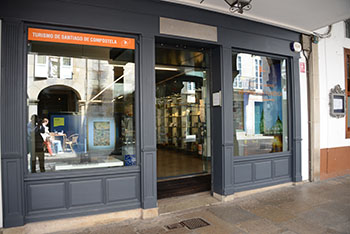
| Place | Turismo de Santiago de Compostela Information Center |
| Address | Rúa do Vilar 63, Santiago de Compostela , Galicia, Spain |
| Phone | +34-981-555-129 |
| Hours | Winter: Mon-Fri 9:00 ~ 19:00 / Sat, Sun, Holy Days. 9:00 ~ 14:00 and 16:00 ~ 19:00. Easter and high season: every day from 9:00 ~ 21:00. |
| Closed | Open year round |
Tanabe City (Japan)
Please register at the Kumano Hongu Heritage Center in Hongu near the Kumano Hongu Taisha, or at the TANABE Tourist Information Center.
NOTE: No pre-registration is needed at the Tanabe Tourist Information Center for the Dual Pilgrim program. Dual Pilgrim completion registration is available at the below locations.

| Place | TANABE Tourist Information Center |
| Address | 1-20 Minato, Tanabe-shi, Wakayama-ken 646-0031 Japan (Next to JR Kii-Tanabe Station) |
| Phone | +81-(0)739-26-9025 or +81-(0)739-34-5599 |
| Hours | 9:00 ~ 18:00 |
| Closed | Open year round |
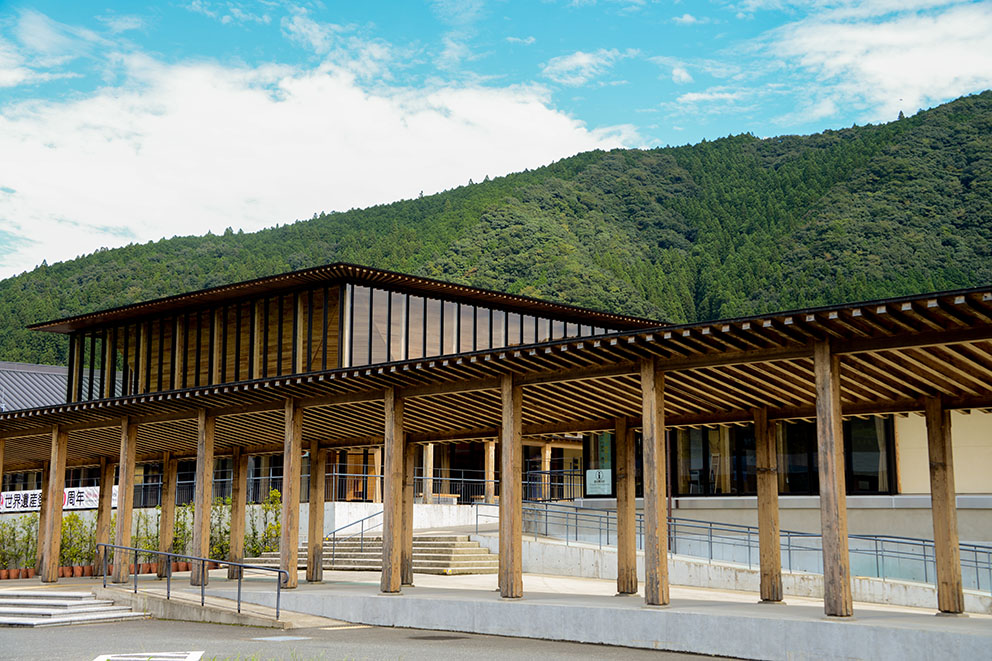
| Place | Kumano Hongu Heritage Center |
| Address | 100-1 Hongucho Hongu, Tanabe-shi, Wakayama-ken 647-1731 Japan |
| Phone | 0735-42-0735 (Kumano Hongu Tourist Association) |
| Hours | 8:30 ~ 17:00 |
Dual Pilgrim Taiko Ceremony
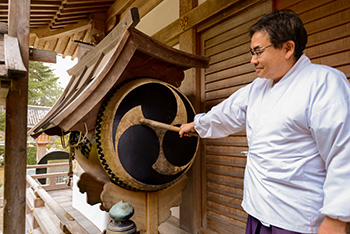
For registered Dual Pilgrims, Kumano Hongu Taisha has a special “Dual Pilgrim Taiko Ceremony”.
During this short ceremony, you can drum on the sacred Taiko to express your feelings, emotions and thoughts—an experience of the body, to complete your spiritual journey.
Please visit the Kumano Hongu Taisha shrine office to register for the ceremony.
NOTE: The ceremony may not be available on all days.
The New Year’s holiday from January 1-3 is particularly busy and the ceremony is not possible at that time, and may be unavailable the first week in January.
Dual Pilgrim Certificate of Completion
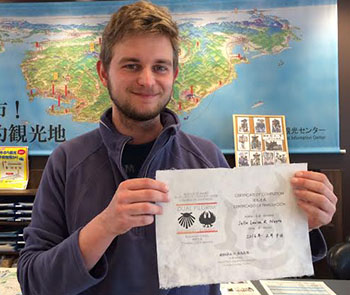
For Dual Pilgrims registering at either Kumano Hongu Heritage Center or the Tanabe Tourist Information Center next to the Kii-Tanabe station, a completion certificate is presented.
This certificate is from the Head Priest of the Kumano Hongu Taisha Grand Shrine to offer gratitude and congratulations to Dual Pilgrims.
The certificate is made from local Washi Japanese handmade paper and features the character for “Way” in the background. This character was written by the Head Priest personally.
This is a great memento to help pilgrims remember their incredible journeys on the Way of St. James and the Kumano Kodo pilgrimage routes.
Dual Pilgrim List
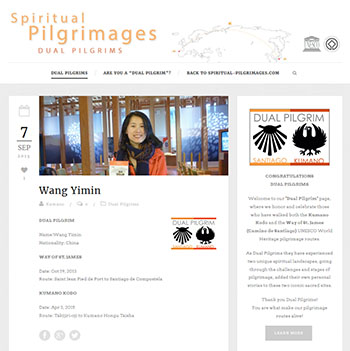
For those Dual Pilgrims that wish to share their experiences, voluntary inclusion on our Dual Pilgrim website is possible.
http://dual-pilgrim.spiritual-pilgrimages.com/
Thank you Dual Pilgrims!
You are what make our pilgrimage routes alive!
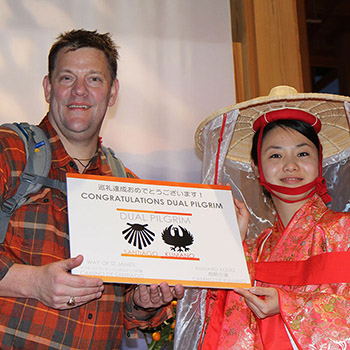
First Dual Pilgrim
Eric Bruce
Feb 5, 2015: American
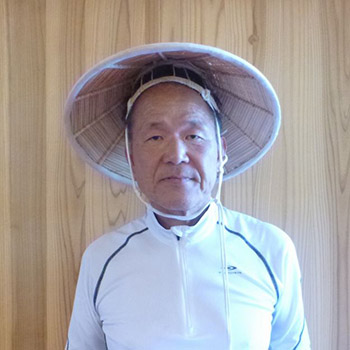
First to Complete Both Sides of Official Dual Pilgrim Credential
Toshinori Koshiba
May 27, 2015: Japanese
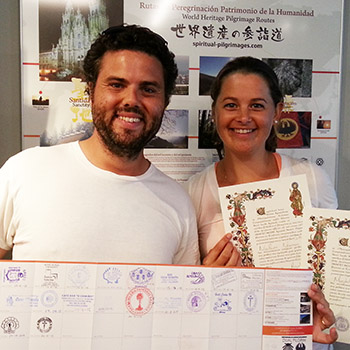
First Registered Dual Pilgrim in Santiago de Compostela
Nicholas & Madeleine Newman
Aug 24, 2015: Australian, New Zealand
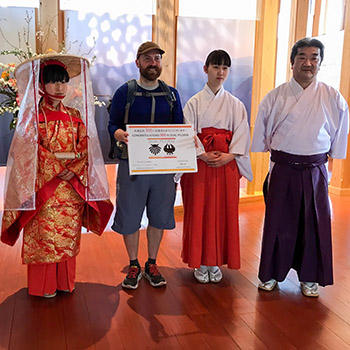
500th Dual Pilgrim
David Whitson
Mar 30, 2017: American
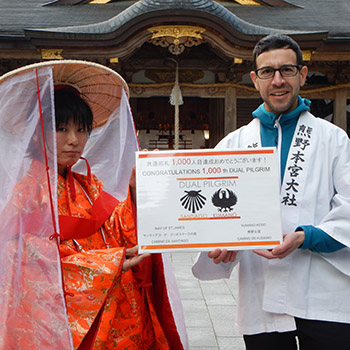
1000th Dual Pilgrim
Stephen Bugno
Feb 21, 2018: American
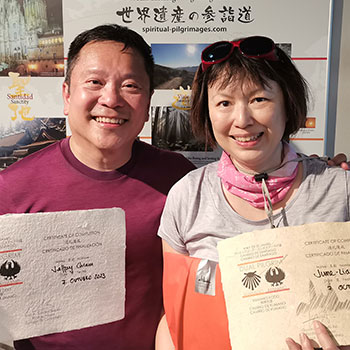
5000th Dual Pilgrim
June-Lian Mok
Oct 7, 2023: Singapore
Dual Pilgrim Statistics
70 countries, 9,019 pilgrims registered
※ to Jan, 2025
| Nationality | Number |
| Japan | 1,766 |
| USA | 1,241 |
| Taiwan | 1,140 |
| Australia | 1,125 |
| Spain | 685 |
| China | 593 |
| Canada | 267 |
| UK | 250 |
| Italy | 231 |
| Singapore | 185 |
Dual Pilgrim Ambassadors
Dual Pilgrim Ambassadors are passionate, dynamic individuals or organizations capable of effectively promoting the two World Heritage pilgrimage networks (Kumano Kodo and Way of St. James) via the Dual Pilgrim initiative, to further foster sustainable tourism and cultural exchange.
Kumano Kodo Women’s Club
A women’s group that enjoys walking the Kumano Kodo and spreading its charm. Formed in May 2017, the club is made up of women mainly from the Tokyo metropolitan area, and currently has 190 members. Their activities are called “women’s training camps” and Kumano Kodo tours are held three to four times a year, with changing members. A Way of St. James pilgrimage tour has been held nine times from 2018 to 2024. There are 19 club members who are Dual Pilgrims, and five more will join them in the fall of 2024 after completed the Way of St. James. Takamori Reiko has completed both routes 6 times.
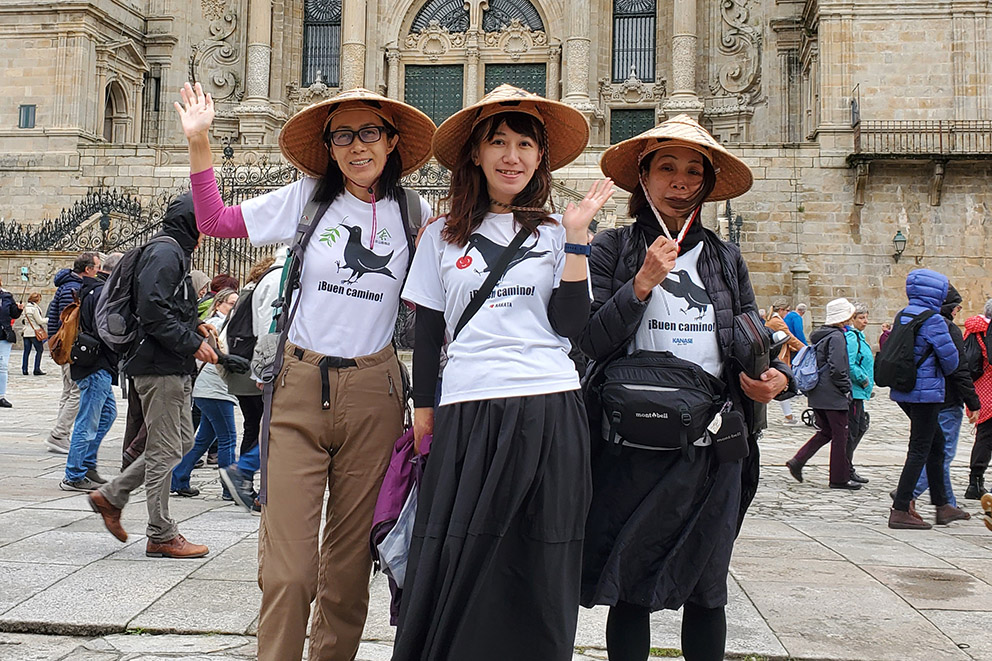
Heather Knight
Ms. Heather Knight is an America who administrates the Facebook groups “Kumano Kodo Planning” and “Camino de Santiago Planning”, supporting people traveling on these respective pilgrimage routes. The members of “Kumano Kodo Planning” Facebook group come from a diverse range of ages and genders, mainly from the U.S.A, Australia, Japan, and Singapore. The group now has over 7,000 participants and focuses on respectful discussions about planning pilgrimage walks on the Kumano Kodo. The sister group, “Camino de Santiago Planning,” has more than 17,000 members.

Ouchi Sei
Low Mountain Traveler/Mountain Travel Writer.
Mr Ouchi Sei explores the charm of local hiking, where you can experience nature, people, history and culture in low mountains and satoyama areas across Japan. His life’s work is walking the Kumano Kodo route and has written articles about the Tanabe/Kumano region in various media.
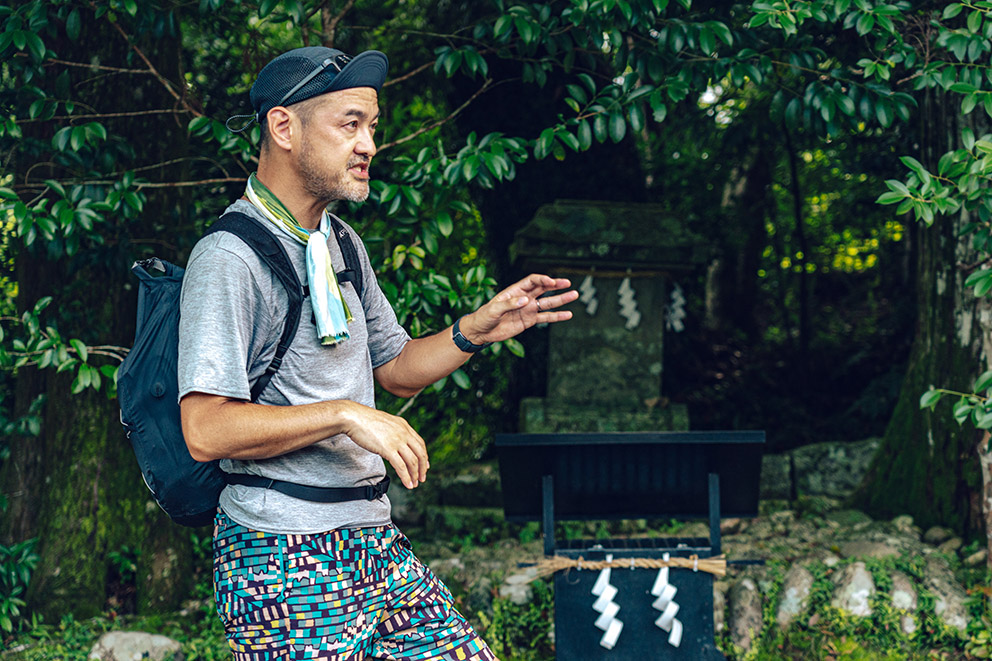
Akagi Mutsuyo
Ms. Akagi Mutsuyo is a painter from Tanabe City who resides in Kyoto Prefecture. Guided by the nature and spirituality of Kumano, she has been using a paintbrush ever since she could remember. In April 2021, a solo exhibition will be held at Kumano Hongu Taisha and the Kumano Hongu Heritage Center with the theme of “To Kumano, the land of resurrection.” In May 2024, to commemorate the 10th anniversary of the Tourism Partnership Cities agreement between Tanabe City and Santiago de Compostela, an exhibition of her works on the Pilgrimage to Santiago in Santiago de Compostela. As well as in Japan with an exhibition in July titled “Mutsuyo Akagi CAMINO Exhibition’” sponsored by the Embassy of Spain.

Manuel Oreiro Romar
President of the Association Casa Galicia-Japón
President Viajes Viloria (travel agency)
Dual Pilgrim FAQs
Q. Do I need to complete both sides of the credential or is it OK if I have already completed the Way of St. James with a different style of passport?
A. You do not have to complete both sides of the Dual Pilgrim credential. It is OK if you use another form of credential or stamp book. For example:
1. Dual Pilgrim Credential for Kumano Kodo and Santiago Cathedral Credential for Way of St. James (or other certified Credential for the Way of St. James).
2. Tourist association passport for Kumano Kodo and Dual Pilgrim Credential for Way of St. James.
3. Tourist association passport for Kumano Kodo and Santiago Cathedral Credential for Way of St. James (or other certified Credential for the Way of St. James).
Q. Which route do I need to do first to be a Dual Pilgrim?
A. It doesn’t matter which order you do them, as long as you have completed both you are a Dual Pilgrim.
Q. Where are the stamps on the Kumano Kodo?
A. The stamps are mostly located in small wooden stands at oji shrines and other historical spots. Ask at the Grand Shrines for the location of these stamps.
Q. Is it OK if I take a bus part-way on the Kumano Kodo?
A. For the Kumano Kodo, yes it is OK to use the bus if needed.
Q. What if I finish my walk in Katsuura? Where do I go to register?
A. The easiest way is to take the train to the Kii-Tanabe station, and register at the Tanabe Tourist Information Center next to the station.
Q. Can the pin badge be mailed to me if I have walked both routes?
A. No, you must go to one of the registration sites to register and receive the pin.
Q. I walked the Way of St. James many years ago. If I walk the Kumano Kodo now, am I still eligible for Dual Pilgrim status?
A. Yes, if you have walked it in the past that is OK. As long as you can prove or state that you have done both when you register that is no problem.
Q. Do I have to have my completed Way of St. James Credential with me when I register to be a Dual Pilgrim after I walk the Kumano Kodo?
A. It is preferred if you did to prove that you have walked the Way of St. James, but not necessary. A picture of your certificate or proof of your Way of St. James completion is OK, and not the original documentation.
Q. Do I need to register for the Dual Pilgrim after I do each one of the pilgrimage routes.
A. No, you only register for Dual Pilgrim status when you have completed the second of the two routes.
Q. What does Credential mean?
A. The Credential is often used for the Way of St. James booklet for collecting stamps along the route. This attests to the authenticity and validity of the document.
Q. On the Santiago de Compostela side of the Credential sheet is says “Official Credential” but on the Kumano Kodo side it doesn’t. Why?
A. The Dual Pilgrim passport has been officially accepted by the Santiago Cathedral as a valid document to use along the Way of St. James. The Kumano Grand Shrines do not have this structure of documentation, so the term official isn’t used on the Kumano Kodo side.
Q. Why is there a sun on the front of the credential?
A. Santiago is in the far West where the sun sets, and Kumano is in the far East where the sun rises. They are connected by the sun.
Santiago de Compostela
The Spanish holy city of Santiago de Compostela has been a spiritual center of Western Europe and the destination of the Middle Ages’ most important religious and cultural movement known as “the Way of St. James pilgrimage”. A network of pilgrimage routes from across Europe lead to this beautiful city on the northwest coast of the Iberian Peninsula. Because of its outstanding universal value it was registered in 1993 as UNESCO World Heritage.
The “Camino” pilgrimage route, as it is known in Spain, and the Kumano Kodo pilgrimage route are the only two pilgrimage routes registered as UNESCO World Heritage.
They share a unique history of human spirituality: “Sister” pilgrimage routes across the globe.
Links
ENGLISH
Santiago de Compostela Tourism Official site
UNESCO Route of Santiago de Compostela
UNESCO Santiago de Compostela (Old Town)
Pilgrimage Exchange
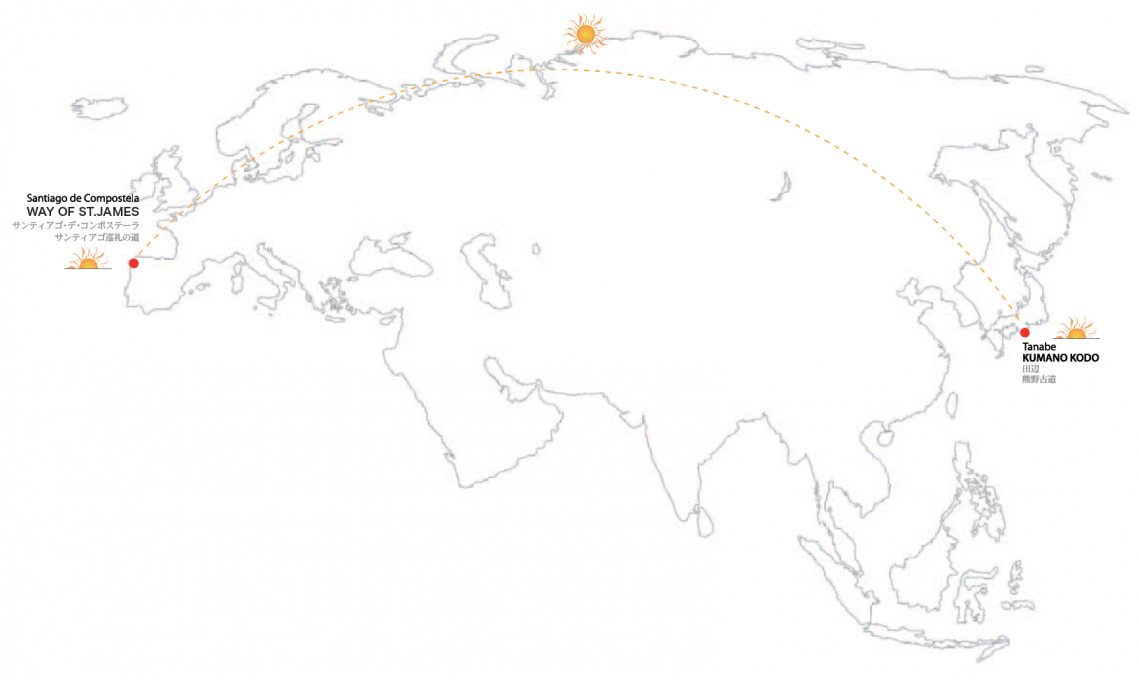
Joint Promotion Agreement
The Tanabe City Kumano Tourism Bureau and Santiago de Compostela Tourism are working together to promote and preserve the unique spiritual cultures of the Asia’s far east and Europe’s far west: the pilgrimages of the rising and setting sun.
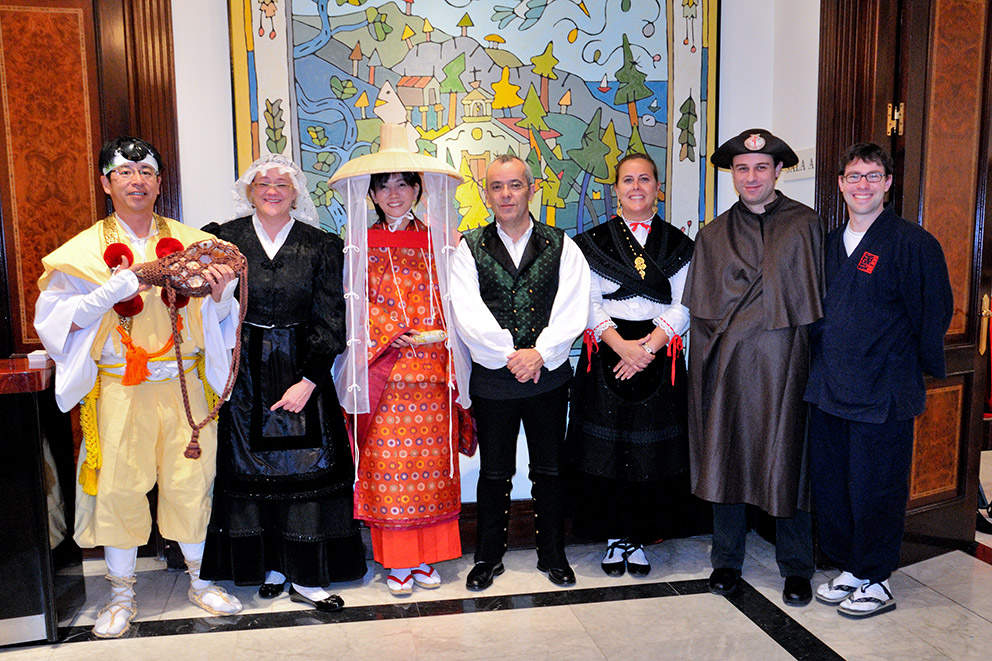
Protocol of Intention
Considering:
Tanabe and Santiago de Compostela share a rich history of pilgrimage tradition. Networks of ancient pilgrimage routes lead to both Tanabe’s Kumano Hongu Taisha Grand Shrine and to the holy city of Santiago de Compostela. The Way of St. James to Santiago de Compostela and the Kumano Kodo to Kumano are the only two pilgrimage routes registered as UNESCO World Heritage.
Both networks of routes originated in the 10th centuries and have been walked by millions of pilgrims over the centuries. Although Kumano is located in the far east of Asia and Santiago is located in the far west of Europe, both of our ancient roads share a common history of faith. They have developed simultaneously as pilgrimage routes and have become beloved by our citizens as important parts of our historical, cultural and spiritual heritage.
2008 marks the 10th anniversary of official relations between Wakayama Prefecture and Galicia Province. A mutual promotion project between Tanabe and Santiago de Compostela will celebrate this anniversary and further deepen positive relations between Wakayama Prefecture and Galicia Province.
Because of the above,
We Agree:
Firstly: To collaborate and cooperate in order to mutually promote our respective pilgrimage routes and cities.
Secondly: To exchange knowledge and experience in regards to promotion and sustainable tourism.
Thirdly: To research new ways to work together towards mutual promotion, development and preservation of our pilgrimage heritage.
Fourthly: To strengthen positive relations between Tanabe & Santiago de Compostela, Wakayama Prefecture & Galica Province, and Japan & Spain.
Fifthly: To respect the rich religious and spiritual heritage of each other’s cultural traditions while carrying out actions and projects.
Date: Monday, 27th of October, 2008
Signed Protocol of Intentions PDF
Tanabe City and Santiago de Compostela “Tourism Partnership Cities”
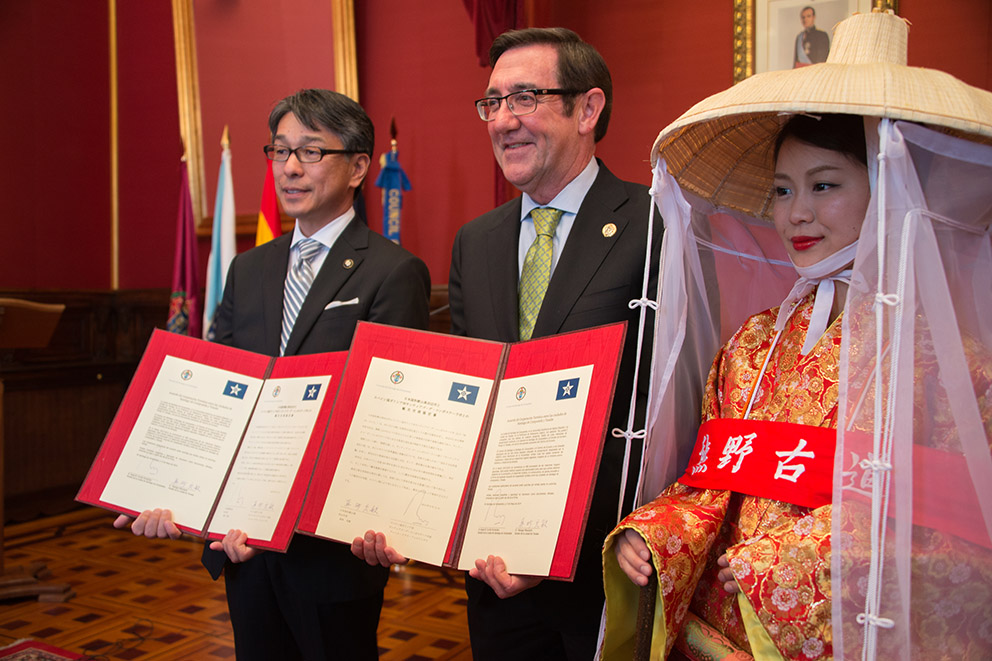
Tanabe City and Santiago de Compostela share many similarities, despite their cultural differences.
This is especially true when referring to the Kumano Kodo and Way of St. James pilgrimage routes that are instrumentally bound to the history and character of both cities.
To celebrate and share together our unique, yet similar identities, Tanabe and Santiago de Compostela have signed an historic “Tourism Partnership Cities” agreement focused on sharing and cooperation.
Tourism Partnership Cities Agreement
Santiago de Compostela in Galicia Region, Spain and Tanabe City in Wakayama Prefecture, Japan (hereinafter ‘the two parties’) share a rich history of pilgrimage tradition. Networks of ancient pilgrimage routes lead to both the cathedral of Santiago de Compostela and Tanabe’s Kumano Hongu Taisha, one of the three Grand Shrines of Kumano.
The Way of St. James to Santiago de Compostela and the Kumano Kodo to the Kumano Grand Shrines, are two unique pilgrimage cultural landscapes, the only two registered as UNESCO World Heritage. The two parties embrace the traditions and cultures of their respective sacred sites, as historically rich capitals.
The year 2013 to 2014 marks the 400th anniversary of Japan-Spain relations. This historical year is an opportunity for the two parties to collaborate together on tourism promotion and development, and therefore sign the “Tourism Partnership Cities” Agreement.
Specific articles of the agreement will be signed by the two parties at a later date.
Both the Spanish and Japanese versions of this agreement shall be certified as official documents, and become effective upon the day of signing.
Date: May 13, 2014 Signing of Agreement in Santiago de Compostela
Tourism Partnership Cities Agreement Articles
Santiago de Compostela in Galicia Region, Spain and Tanabe City in Wakayama Prefecture, Japan (hereinafter ‘the two parties’), home to the Way of St. James and Kumano Kodo pilgrimage routes, share two unique pilgrimage cultural landscapes, the only two registered as UNESCO World Heritage.
On May 13, 2014 the two parties signed a “Tourism Partnership Cities” Agreement in Santiago de Compostela to collaborate together on tourism promotion and development.
To further deepen tourism ties the following articles of the agreement will be signed by the two parties.
We hereby agree:
Article 1 To responsibly collaborate together while respecting our historical, cultural, traditional, and spiritual heritages.
Article 2 To cooperate towards promoting and developing our tourism assets while striving to become sustainable tourism destinations.
Article 3 To share knowledge on how to reduce adverse environmental impacts, giving visitors and pilgrims an increased opportunity to travel more environmentally friendly.
Article 4 To deepen mutual understanding by facilitating diverse exchanges focused on tourism at the government, private, and community levels.
Article 5 That all aspects of this agreement, and subsequent collaboration, conform to the laws and ordinances of our respective countries.
Article 6 That both the Spanish and Japanese versions of this agreement shall be certified as official documents, and become effective upon the day of signing.
Date: July 6, 2014 Signing of Articles in Tanabe City
Joint Projects
